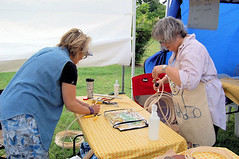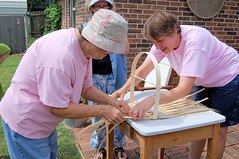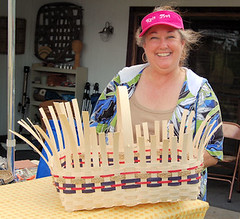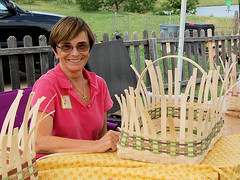 First a little history:
First a little history:Sometime probably in the late 70's or early 80's there was a weaver named Ellie who bought a new 45 inch 8 harness Herald loom with a sectional beam. I am sure Ellie dreamed of all the wonderful things she would weave on that loom.
Life must have interfered, because she never go around to weaving on her new loom. It never had a warp.
This year, Ellie, whose memory is failing, moved to assisted living. The unused loom remained behind, stored in a garage with only rats and mice for company. The harnesses collected a little rust.
Ellie's close friend and neighbor began the hard task of cleaning out Ellie's house. The loom went up for sale to another weaver.
 ------
------Over the last several years, I have been teaching myself to weave. When I started, I thought I would never get a 4 harness loom threaded properly. I marveled that anyone would ever want more harnesses.
However, time in the chair has cured most of my early problems with crossed threads and missed headles. So I decided that if a loom appeared with more than 4 harnesses and if it were inexpensive enough to get passed my strong tightwad nature, I would buy it.
I was at knitting group one day talking about this to some other weavers, and I told them that I was convinced my new loom would find me.
Then, over a week ago, there was a posting to both Weaver's Guilds that I belong to that there was an 8 harness loom for sale. The price was right but I hit delete on the emails because I just had no time to investigate the loom. I was going out of town for several days so the timing was just all wrong.
My friend Kay, of Cordova Studios, also knew that I was looking for a loom, so she kindly forwarded me the email announcement which I saw for the third time. I hit delete. I was just too busy to look into it.
 I thought about it all weekend while I was gone. I finally decided that if the loom was still available when I got back (and I thought that was unlikely) that I would check on it and go look at it. So I did.
I thought about it all weekend while I was gone. I finally decided that if the loom was still available when I got back (and I thought that was unlikely) that I would check on it and go look at it. So I did.The loom had not been sold to my surprise. No one had even looked at it. When I saw it, I knew my loom had indeed found me.
It took me a day to get it cleaned up. My husband has adjusted the brake. I think it is ready to warp.
I am now re-reading all my weaving publications, paying attention to all the new possibilities that 8 harnesses bring. I think it will keep me busy for a long time.
Now to get a warp on it!



















